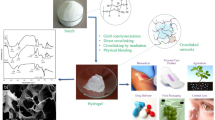Abstract
Hydrogels are widely used in medical, food and other applications due to their good water absorption without dissolution. The objective of this work was to synthesize a maleated poly(vinyl alcohol) (PVAM) grafted copolymer with anionic polyacrylamide (PAM) (PVAM-graft-PAM) using K2S2O8 as an initiator in an eco-friendly process. The chemical structure of the PVAM-graft-PAM was confirmed by FTIR. The influences of the PVAM/PAM ratio and the natural rubber-graft-cassava starch (NS) and PVAM/PAM ratio on the properties of the PVAM-graft-PAM were investigated. It was observed that the swelling ratio of the sample was enhanced with increasing PAM portions in the PVAM-graft-PAM. However, as the quantity of NS in the graft copolymer increased, the swelling ratio decreased. In addition, the PVAM-graft-PAM was sensitive to variation in pH due to the presence of carboxylic and amide groups on the grafting structure. After the preparation of the PVAM-graft-PAM, it was used in the controlled release of retinoic acid. After use, the resulting hydrogel degraded easily in natural soil.












Similar content being viewed by others
References
Sukhlaaied W, Riyajan S-A (2013) Synthesis and properties of carrageenan grafted copolymer with poly(vinyl alcohol). Carbohyd Polym 98:677–685
Aycan D, Alemdar N (2018) Development of pH-responsive chitosan-based hydrogel modified with bone ash for controlled release of amoxicillin. Carbohyd Polym 184:401–407
Sukhlaaied W, Riyajan S-A (2014) Green synthesis and physical properties of poly(vinyl alcohol) maleated in an aqueous solutions. J Polym Environ 22:350–358
Riyajan S-A, Sukhlaaied W, Keawmang W (2015) Preparation and properties of a hydrogel of maleated poly(vinyl alcohol) (PVAM) grafted with cassava starch. Carbohyd Polym 122:301–307
Sukhlaaied W, Riyajan S-A (2016) Preparation and properties of a novel environmentally friendly film from maleated poly(vinyl alcohol) grafted with chitosan in solution form: the effect of different production factors. Polym Bull 73:791–813
Sukhlaaied W, Riyajan S-A (2016) Green robust pH–temperature-sensitive maleated poly(vinyl alcohol)-g-gelatin for encapsulated capsaicin A. Polym Bull 73:2303–2320
Sukhlaaied W, Riyajan S-A (2017) A novel pH and temperature-sensitive maleate poly(vinyl alcohol)-graft-isopropylacrylamide/natural rubber blend: preparation and properties. Polym Bull 74:803–821
Su Q, Duan L, Zou M, Chen X, Gao GH (2017) The tough allograft adhesive behavior between polyacrylamide and poly(acrylic acid) hydrophobic association hydrogels. Mater Chem Phys 193:57–62
Velichko EV, Buyanov AL, Saprykina NN, Duif CP, Bouwman WG, Smyslov RY (2017) High-strength bacterial cellulose–polyacrylamide hydrogels: mesostructure anisotropy as studied by spin-echo small-angle neutron scattering and cryo-SEM. Eur Polym J 88:269–279
Hanyková L, Spěváček J, Radecki M, Zhigunov A, Kouřilová H, Sedláková Z (2016) Phase transition in hydrogels of thermoresponsive semi-interpenetrating and interpenetrating networks of poly(N,N-diethylacrylamide) and polyacrylamide. Eur Polym J 85:1–13
Hosseinzadeh H, Ramin S (2018) Fabrication of starch-graft-poly(acrylamide)/graphene oxide/hydroxyapatite nanocomposite hydrogel adsorbent for removal of malachite green dye from aqueous solution. Int J Biol Macromol 106:101–115
Tan H, Tu S, Zhao Y, Wang H, Du Q (2018) A simple and environment-friendly approach for synthesizing macroporous polymers from aqueous foams. J Colloid Interface Sci 509:209–218
Aderibigbe BA, Ndwabu S (2017) Evaluation of whey protein isolate-graft-carbopol-polyacrylamide pH-sensitive composites for controlled release of pamidronate. Polym Bull 74:5129–5144
Riyajan S-A (2017) PH-sensitive absorbent: anionic polyacryamide/cassava starch hydrogels containing natural rubber for lead and magnesium removal from aqueous solution. KGK Kautschuk Gummi Kunststoffe 70:49–53
Riyajan S-A, Wongsa C (2013) Effect of natural rubber on polymer hydrogel produced from polyacrylamide and starch using the microwave method. KGK Kautschuk Gummi Kunststoffe 66:23–28
Riyajan S-A, Sasithornsonti Y, Phinyocheep P (2012) Green natural rubber-g-modified starch for controlling urea release. Carbohyd Polym 89:251–258
Riyajan S-A (2015) Robust and biodegradable polymer of cassava starch and modified natural rubber. Carbohyd Polym 134:267–277
Ivan’kova EM, Dobrovolskaya IP, Popryadukhin PV, Kryukov A, Yudin VE, Morganti P (2016) In-situ cryo-SEM investigation of porous structure formation of chitosan sponges. Polym Test 52:41–45
Riyajan S-A, Keawittarit P (2016) A novel natural rubber-graft-cassava starch foam for oil/gasohol absorption. Polym Int 65:491–502
Sukhlaaied W, Riyajan S-A (2017) Physical properties of smart maleated poly(vinyl alcohol)-g-poly (N-isopropylacrylamide) and natural rubber latex. KGK Kautschuk Gummi Kunststoffe 70:19–26
Riyajan S-A (2017) Physical property testing of a novel hybrid natural rubber-graft-cassava starch/sodium alginate bead for encapsulating herbicide. Polym Test 58:300–307
Riyajan S-A, Sakdapipanich JT (2009) Development of a controlled release neem capsule with a sodium alginate matrix, crosslinked by glutaraldehyde and coated with natural rubber. Polym Bull 63:609–622
Zuccari G, Carosio R, Fini A, Montaldo PG, Orienti I (2005) Modified polyvinylalcohol for encapsulation of all-trans-retinoic acid in polymeric micelles. J Control Release 103:369–380
Gouda R, Baishya H, Qing Z (2017) Application of mathematical models in drug release kinetics of carbidopa and levodopa ER tablets. J Dev Drugs 6:1–6
Gallert C (2000) Degradation of latex and of natural rubber by Streptomyces strain La7. Syst Appl Microbiol 23:433–441
Magdaliniuk S, Block JC, Leyval C, Bottero JY, Villemin G, Babutt M (1995) Biodegradation of naphthalene in montmorillonite/polyacryamide suspensions. Water Sci Technol 31:85–94
Corti A, Solaro R, Chiellini E (2002) Biodegradation of poly(vinyl alcohol) in selected mixed microbial culture and relevant culture filtrate. Polym Degrad Stab 75:447–458
Joshi SJ, Abed RM (2017) Biodegradation of polyacrylamide and its derivatives. Environ Process 4:463–476
Rebia RA, Rozet S, Tamada Y, Tanaka T (2018) Biodegradable PHBH/PVA blend nanofibers: fabrication, characterization, in vitro degradation, and in vitro biocompatibility. Polym Degrad Stab 154:124–136
Acknowledgements
The author gratefully acknowledges the financial support provided by Thammasat University Research Fund under the TU Research Scholar, Contract No. 2/50/2018, the Center of Scientific Equipment for Advanced Research, Thammasat University and the Center of Scientific Equipment, Faculty of Science and Technology, Thammasat University. This study was financially supported by The Thailand Research Fund/Prince of Songkla University/Thammasat University (RSA5780018) and by Thammasat University.
Author information
Authors and Affiliations
Corresponding author
Rights and permissions
About this article
Cite this article
Riyajan, SA. Development of a novel pH-sensitive polymer matrix for drug encapsulation from maleated poly(vinyl alcohol) grafted with polyacrylamide. Polym. Bull. 76, 4585–4611 (2019). https://doi.org/10.1007/s00289-018-2615-4
Received:
Revised:
Accepted:
Published:
Issue Date:
DOI: https://doi.org/10.1007/s00289-018-2615-4




